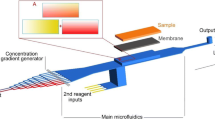Abstract
We present a 2-layer based microfluidic concentration generator by a hybrid of a serial and a volumetric dilution for dose-response experiments in drug screening. The hybrid dilution method using 2-layer based microfluidic network significantly reduces the total number of cascaded serial dilution stages. The proposed strategy is capable of generating a large number of universal stepwise monotonic concentrations with a wide range of logarithmic and linear scales. We have studied an equivalent electrical circuit to that of the 2-layer based microfluidic network, where the only variable parameter is channel length. We have designed a microfluidic dilution generator simultaneously covering 14 doses with a combination of 4-order logarithmic and 4-point linear concentrations. The design has been verified by a commercial circuit analysis software (e.g., P-Spice) for the electrical circuit analysis and a computational fluid dynamics software (e.g., CFD-ACE+) for the microfluidic circuit analysis. As a real-life application of the proposed dilution generator, we have successfully performed a dose-response experiment using MCF-7 human breast cancer cells. We expect that the proposed dilution method will be useful to study not only high throughput drug screening but also optimization in biology, chemistry, medicine, and material sciences.







Similar content being viewed by others
References
D. Amarie, J.A. Glazier et al., Compact microfluidic structures for generating spatial and temporal gradients. Anal. Chem. 79(24), 9471–9477 (2007)
K. Campbell, A. Groisman, Generation of complex concentration profiles in microchannels in a logarithmically small number of steps. Lab Chip 7(2), 264–72 (2007)
J.K. Chang, H. Bang et al., Fabrication of the PDMS microchip for serially diluting sample with buffer. Microsystem Technologies-Micro-and Nanosystems-Information Storage and Processing Systems 9(8), 555–558 (2003)
S.K.W. Dertinger, D.T. Chiu et al., Generation of gradients having complex shapes using microfluidic networks. Anal. Chem. 73(6), 1240–1246 (2001)
P.S. Dittrich, A. Manz, Lab-on-a-chip: microfluidics in drug discovery. Nat. Rev. Drug. Discov. 5(3), 210–218 (2006)
F. Greve, L. Seemann et al., A hybrid microsystem for parallel perfusion experiments on living cells. J. Micromechanics Microengineering 17(8), 1721–1730 (2007)
K. Hattori, S. Sugiura et al., Generation of arbitrary monotonic concentration profiles by a serial dilution microfluidic network composed of microchannels with a high fluidic-resistance ratio. Lab Chip 9, 1763–1772 (2009)
Eli Lilly and Company and the National Institutes of Health Chemical Genomics Center (2008). Assay guidance manual 5.0 (http://www.ncgc.nih.gov/guidance/)
J.G. Hong, J.B. Edel et al., Micro- and nanofluidic systems for high-throughput biological screening. Drug Discov. Today 14(3–4), 134–146 (2009)
D. Irimia, S.Y. Liu et al., Microfluidic system for measuring neutrophil migratory responses to fast switches of chemical gradients. Lab Chip 6(2), 191–198 (2006)
R.F. Ismagilov, J.M.K. Ng et al., Microfluidic arrays of fluid-fluid diffusional contacts as detection elements and combinatorial tools. Anal. Chem. 73(21), 5207–5213 (2001)
S.C. Jacobson, T.E. McKnight et al., Microfluidic devices for electrokinetically driven parallel and serial mixing. Anal. Chem. 71(20), 4455–4459 (1999)
X.Y. Jiang, J.M.K. Ng et al., A miniaturized, parallel, serially diluted immunoassay for analyzing multiple antigens. J. Am. Chem. Soc. 125(18), 5294–5295 (2003)
T.M. Keenan, A. Folch, Biomolecular gardients in cell culture systems. Lab Chip 8, 34–57 (2008)
L. Kim, M.D. Vahey et al., Microfluidic arrays for logarithmically perfused embryonic stem cell culture. Lab Chip 6(3), 394–406 (2006)
C. Kim, K. Lee et al., A serial dilution microfluidic device using a ladder network generating logarithmic or linear concentrations. Lab Chip 8(3), 473–479 (2008)
K. Lee, C. Kim et al., Generalized serial dilution module for monotonic and arbitrary microfluidic gradient generators. Lab Chip 9(5), 709–717 (2009)
F. Lin, W. Saadi et al., Generation of dynamic temporal and spatial concentration gradients using microfluidic devices. Lab Chip 4(3), 164–167 (2004)
C. Neils, Z. Tyree et al., Combinatorial mixing of microfluidic streams. Lab Chip 4(4), 342–350 (2004)
J. Olechno, J. Shieh et al., Improving IC50 results with acoustic droplet ejection. JALA 11, 240–246 (2006)
B.M. Paegel, W.H. Grover et al., Microfluidic serial dilution circuit. Anal. Chem. 78(21), 7522–7527 (2006)
C. G. Smith, J. T. O’Donnell, The process of new drug discovery and development. (Informa Health Care, 2006)
J.A. Timbrell, Principles of biochemical toxicology. (Taylor & Francis, 2000)
B.H. Weigl, R.L. Bardell et al., Lab-on-a-chip for drug development. Adv. Drug Deliv. Rev. 55(3), 349–377 (2003)
M. Yamada, T. Hirano et al., A microfluidic flow distributor generating stepwise concentrations for high-throughput biochemical processing. Lab Chip 6(2), 179–184 (2006)
A. Yang, D.L. Cardona et al., Subacute cytotoxicity testing with cultured human lung cells. Toxicol. In Vitro 16(1), 33–39 (2002)
Acknowledgment
This work was supported in part by the National Science Foundation under ECCS/EPDT program (contract #0736501) and the NYSTAR Faculty Development program. This research was supported in part by the Intelligent Microsystem Center, which is carrying out one of the 21st Century’s Frontier R&D Projects sponsored by the Korea Ministry of Commerce, Industry and Energy.
Author information
Authors and Affiliations
Corresponding author
Rights and permissions
About this article
Cite this article
Lee, K., Kim, C., Kim, Y. et al. 2-layer based microfluidic concentration generator by hybrid serial and volumetric dilutions. Biomed Microdevices 12, 297–309 (2010). https://doi.org/10.1007/s10544-009-9385-6
Published:
Issue Date:
DOI: https://doi.org/10.1007/s10544-009-9385-6




